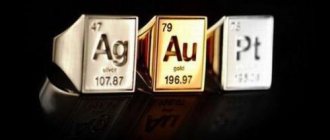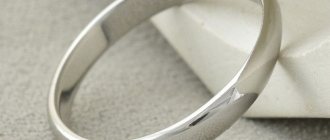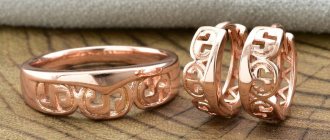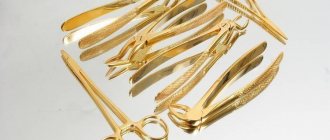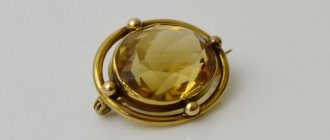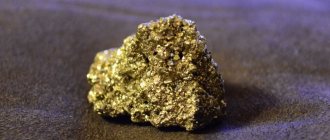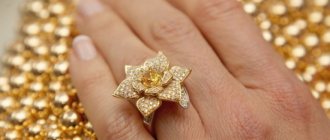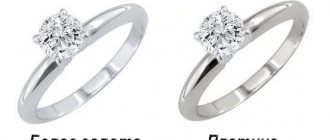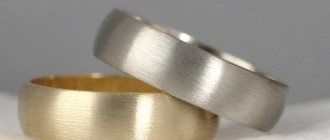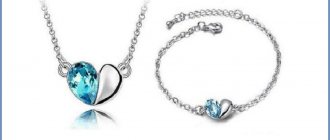White gold is an alloy of gold. It is made by mixing pure gold with silvery-white metals such as silver and palladium. It was originally designed to imitate platinum, a precious white metal.
In the industry, the term "white gold" is often used to describe karat gold alloys with a whitish tint. The word "white" refers to a wide range of colors that overlap with pale yellow, pale pink and brown.
The characteristics of white gold depend on the metal alloys and their proportions. Therefore, white gold alloys can have several different uses.
What is white gold made of?
White gold is composed primarily of gold and a mixture of dense metals such as copper, zinc, nickel, rhodium or palladium. The white color is achieved by carefully selecting alloying metals that bleach the reddish-yellow color of pure gold.
The amount of gold is measured in a unit called karats (K). In 24 karat gold, all 24 parts of gold are pure gold with extremely low levels of impurities.
Similarly, 18k gold contains 75% (or 18/24) gold, while 22k gold is 91.6%.
The proportion of alloy added affects the overall durability and final color of the gold. For example, 22 karat gold is stronger and has a more yellowish tint than 18 karat gold.
As a rule, white gold is marked as 18 carats. It contains 75% gold and approximately 25% nickel and zinc. Some types of white gold contain 90% gold and 9.5% nickel. To increase ductility, a small amount of copper is added to it.
White gold used in the jewelry industry is an alloy of gold-nickel-copper-zinc or gold-palladium-silver. Nickel and palladium act as primary bleaching agents to reduce the color of gold, and zinc acts as a secondary bleaching agent for copper.
Table: sample ratio between systems
| Piece of pure precious metal | Metric system, standard | Carat system, carat |
| 99,9% | 999 | 24 |
| 95,8% | 958 | 23 |
| 75% | 750 | 18 |
| 58,5% | 585 | 14 |
| 58,3% | 583 | 14 |
| 50% | 500 | 12 |
| 37,5% | 375 | 9 |
Why is gold alloyed with other metals?
Because pure gold is a very soft and malleable metal, it is alloyed with a mixture of metals to increase strength and durability for use in jewelry. In fact, the gold you see in any industry is rarely pure. Some impurities (such as mercury) are added before alloying to produce white gold. Without harder alloys, pure gold would not be able to maintain its desired shape—gold itself would be too soft.
18k white gold chain
Some white gold jewelry is additionally plated with rhodium, a rare silvery-white metal. It enhances the shine and durability of jewelry, giving it smoothness and shine.
Jeweler's comment
Molokanov N.M.
Jeweler, 26 years of experience in jewelry production.
In addition to the main signs of the quality of jewelry (the sound of falling on glass, color, weight), you can focus on price. This is an indirect factor and cannot be taken as the main one. However, most often low-quality products or counterfeits are sold at reduced prices.
How is gold different from platinum?
Although they look very similar, platinum and white gold are different metals. They have their own properties and advantages that make them unique.
Platinum is a precious silvery-white metal that does not need to be alloyed to impart color. It is rarer than gold and is stronger and denser than white gold.
Unlike white gold, platinum jewelry is purer: it contains 95-98% platinum and 5-3% silver and rhodium.
Because gold jewelry contains more alloys (which is supposed to provide extra strength and durability), it costs less than platinum jewelry.
Both metals have the same cost per ounce (about $1,900 per ounce), but jewelry requires more platinum because it is denser. Due to its higher melting point, platinum is more difficult to process. These are some reasons why platinum rings cost more than white gold rings.
The other main difference is that 22, 18, or 14 karat gold is harder to scratch than platinum. Additionally, gold jewelry requires less cleaning and polishing. This is not the case with platinum jewelry - the cost of maintaining it is quite high as it needs to be cleaned and polished at regular intervals to maintain its smooth and shiny appearance.
Platinum (left) and white gold ring on the right.
However, both white gold and platinum have the same white color. It is quite difficult to notice the difference with the naked eye.
Quick comparison
| White gold | Platinum |
| Mixes with other metals such as copper and nickel. 18K contains 75% gold 14K contains 58.3% gold | Mixed with other metals such as palladium and copper Contains 95-98% platinum. |
| With a specific gravity of 19.3, gold is lighter than platinum. | Heavier than gold; specific gravity 21.4 |
| Affordable compared to platinum | 30-50% more expensive than white gold |
| It requires cleaning and polishing every few years to maintain its shiny appearance. | Cleaning and repolishing should be done regularly to maintain color and shine. |
| When scratching, a tiny amount of gold is lost | The platinum is scratched, but this is just movement of the metal parts, and not a single volume of it is lost. |
| Because it contains a mixture of metals, some of these metals, such as nickel, may cause an allergic reaction when worn for long periods of time. | Unlikely to cause allergic reactions |
Precious nobility
Professionals call an alloy noble if its composition includes platinum and palladium. The mark will tell you which element is included in your jewelry. If platinum is used to create the product, the shape of the mark applied to it will be rectangular. Such jewelry belongs to the premium category; they can only be bought in large jewelry stores, the assortment of which is designed for a certain segment of society whose capabilities allow them to make such expensive purchases.
If the composition of the jewelry ligature includes nickel, zinc, silver and gold, its selling price will not differ from the price of products made of gold of the corresponding standard.
Advantages and disadvantages of white gold
Like any other alloy, white gold has its advantages and disadvantages.
Advantages
- It will not rust, tarnish or corrode.
- Compared to rose gold, white gold can be mixed with stronger metals, making jewelry more scratch-resistant and durable.
- The cost is 50% lower than platinum jewelry.
- White gold can have more intricate designs than platinum.
Flaws
- The rhodium plating wears off over time, so it needs to be replaced every few years.
- Requires cleaning and polishing every few years to maintain its smoothness and shine. However, this is a fairly simple and inexpensive process.
- Nickel alloyed white gold may cause an allergic reaction in some people.
Imported ligature gold plated price per kg
Most often, foreign jewelry differs from domestic samples. In their composition, the proportion of alloys exceeds the amount of noble metals. American and European standards have a certain similarity with Russian ones, but the hallmark is affixed in carats. You can often buy a fake with a precious coating.
Abroad, low-karat gold is very popular for making jewelry, due to its more suitable consumer characteristics. 9-12 carats are much stronger and harder, they are characterized by high resistance to deformation and scratches. In Russia, products with a lower proportion of impurities are more popular: the higher the standard, the greater the demand.
Ligature with gilding imported
Turkish gold is stamped with three numbers 585. No other designations are provided. A large proportion of the alloy is copper, which can be determined by the excessive redness of the products. Gilded silver items are often passed off as jewelry. Jewelry becomes dull and deformed over time. However, purchases remain at a high level due to the affordable price.
There are also Emirati jewels. They contain a minimal proportion of ligature. Only 2 samples are used: 916 and 958. Jewelry is short-lived, so in the country it is customary to wear them only for weddings. Then the jewelry is simply stored in boxes.
Other types of colored gold
Pure gold is a soft, slightly reddish-yellow metal. However, when alloyed with harder metals, it produces a range of colors including yellow, red, green, purple, blue and black.
Yellow Gold: Has a unique warm glow. It is considered more traditional than white gold. Unlike white gold and platinum, which look the same, yellow gold is difficult to imitate.
It is usually alloyed with copper and silver. Most 18k yellow gold items contain 75% gold, 12.5% copper and 12.5% silver. A darker yellow color is achieved by increasing the amount of copper to 15%.
Rose Gold and Red Gold: Seem similar, but the difference lies in the copper content. The higher the concentration of copper in the alloy, the darker the red color. Red gold contains the most copper, while rose gold contains the least. Sometimes zinc is added to the alloy to give it a reddish-yellow color.
18K rose gold contains 75% gold, 20% copper and 5% silver; 18K rose gold has the same amount of gold with 22% copper, 4% silver; and 18K red gold contains 25% copper and no silver. 12K red gold contains gold and copper in equal proportions.
Blue gold: is an intermetallic compound obtained by mixing gold with indium or gallium. The first contains 54% indium and 46% gold, and the second contains 59% gold and 41% gallium.
Purple Gold: is an alloy of gold (79%) and aluminum (21%). These intermetallic compounds are quite rare and more brittle than most gold alloys.
Black gold: obtained through various surface treatment methods. Gold alloys with a high copper content can be dyed a variety of colors from black to brown by treating them with potassium sulfide.
Black gold can also be produced by controlled oxidation of gold alloys containing cobalt or chromium, or by creating nanostructures on the surface using a femtosecond laser.
Gray Gold: Typically produced by mixing gold (75-76%) with palladium (15-23%) and rhodium (1-5%). 18K gray gold can also be produced without bleaching elements such as palladium, nickel and cobalt - this inexpensive alternative includes 75-78% gold, 7-15% manganese, 1-10% silver and 1-2% copper.
Green Gold: Made by adding 4% cadmium. Its use is generally reduced because cadmium is toxic.
The historical fact of the appearance of ligatures in the monetary system
The physical characteristics of the noble metal became the reason for the search for methods to increase the hardness of gold back in the Middle Ages. Coins made from pure precious metal lost weight and became deformed over time. Then a ligature for gold appeared in the monetary system, which made it possible to prevent the erasure of coins due to the addition of non-ferrous metals.
Gold bars
This decision caused differences between the images on the coins and their actual composition. This difference began to be noticed by the “money changers” of that time, who checked the authenticity of the coins by rubbing them on a mat. Money made of pure gold shrank, lost weight, and the mat accumulated a large amount of the noble metal.
Gradually, the full-value coins in circulation ran out, leaving only the inferior ones. Old means of payment have depreciated.
FAQ
Does white gold occur in nature?
No, white gold does not occur in nature. It is made by hand by adding silver-white metals. The first versions of white gold were created in the 18th century in Germany. However, white gold, a replacement for platinum, was first produced in the 1920s.
How rare is white gold?
White gold is not that rare because it is made from gold, which is often found in free elemental (native) form as well as in minerals.
Platinum, however, is very rare. It is one of the rarest metals in the earth's crust, with an average content of about 5 micrograms per kilogram. With only a few hundred tons produced each year, platinum is one of the major precious metals.
Can regular white gold turn yellow?
Nowadays, almost every piece of white gold jewelry is plated with rhodium (a silvery-white metal), so it will not yellow or tarnish with normal wear. However, this coating must be replaced every few years. Otherwise, the rhodium gradually wears away, revealing the true tone of white gold.
Can hand sanitizer damage white gold jewelry?
Yes, anything containing alcohol can damage white gold jewelry. Because alcohol is corrosive, it can gradually eat away at the metal finish of jewelry. If the sanitizer contains excessive amounts of alcohol, it may cause white gold jewelry to lose its luster more quickly.
White gold contains cheaper alloys, which means the purity (karat) of your gold jewelry is reduced. It is for this reason that white gold has a lower resale value than 22K or 18K yellow gold. If you are buying jewelry for investment purposes, it is better to choose purer, reddish-yellow gold or silver-white platinum.
Manufacturing process
White gold is made in two main ways. The more expensive alloy, obtained with the addition of platinum, does not require additional processing, so its manufacturing scheme is simple:
- In industrial conditions, pure gold is melted, which happens quickly, because its melting point is low.
- Then the ligature is prepared. Metals that will later be included in the alloy are carefully measured so that their content strictly corresponds to the standard. They are also melted and then mixed until a homogeneous mass is formed.
- The most difficult stage is the last one, where you need to mix the ligature and gold. In this case, all necessary conditions must be observed, otherwise the product will be of poor quality.
This is where the production of the expensive version ends, but with the cheap one everything is somewhat more complicated. It contains nickel, which not only can be an allergen, but also affects the color of the product in a negative way. Therefore, such jewelry is not produced in its natural form. As a rule, they are coated on top with rhodium, an extremely expensive metal that is part of the platinum group. This procedure is called rhodium plating.
After such treatment, the owner of the jewelry will not come into contact with nickel, but with rhodium, so allergies are excluded. Sometimes this metal is included in an alloy, then the coating is made of ruthenium, which is part of the same platinum group, but is more common and has a lower price.
However, rhodium-plated products have disadvantages, and the main one is the coating that gradually wears off. It is best not to wear them every day, putting them on only for the most special moments. This way the original look will last longer.
Other colors
Modern technologies make it possible to create gold alloys of almost any shade, but not all of them have sufficient characteristics to enter the wide market. So, there are several technologies for inventing purple gold. But such products are not always practical.
In Uralsk, scientists at the Physical Institute of Metals have come up with a way to create green, purple, blue, violet and black gold.
In addition, scientists have discovered the fact that when certain conditions are compared, the surface of gold can acquire different shades. By experimenting with yellow gold, it was possible to achieve a deep blue tint of the alloy.
Use Cases
White metal is so popular precisely because it has virtually no restrictions on its use. Jewelry made from it can be of any size and shape and still look great.
Earrings, rings, bracelets, necklaces, chains and other accessories of any complexity are made from it. It goes well with any precious stones, but diamonds or moonstone look especially elegant when framed with it.
Both men and women of any age can wear such jewelry. It is also suitable for small children who are just beginning to form their preferences. And if some more traditional options - for example, gold in the usual yellow shade - may become outdated over time , then the stylish white color will never go out of fashion.
